The IT Security team has identified that there is an ongoing credential stuffing attack on many of their organization’s system.
What is the BEST way to find recent and ongoing login attempts to Snowflake?
A user named USER_01 needs access to create a materialized view on a schema EDW. STG_SCHEMA. How can this access be provided?
A company's Architect needs to find an efficient way to get data from an external partner, who is also a Snowflake user. The current solution is based on daily JSON extracts that are placed on an FTP server and uploaded to Snowflake manually. The files are changed several times each month, and the ingestion process needs to be adapted to accommodate these changes.
What would be the MOST efficient solution?
Files arrive in an external stage every 10 seconds from a proprietary system. The files range in size from 500 K to 3 MB. The data must be accessible by dashboards as soon as it arrives.
How can a Snowflake Architect meet this requirement with the LEAST amount of coding? (Choose two.)
A company wants to Integrate its main enterprise identity provider with federated authentication with Snowflake.
The authentication integration has been configured and roles have been created in Snowflake. However, the users are not automatically appearing in Snowflake when created and their group membership is not reflected in their assigned rotes.
How can the missing functionality be enabled with the LEAST amount of operational overhead?
Why might a Snowflake Architect use a star schema model rather than a 3NF model when designing a data architecture to run in Snowflake? (Select TWO).
The diagram shows the process flow for Snowpipe auto-ingest with Amazon Simple Notification Service (SNS) with the following steps:
Step 1: Data files are loaded in a stage.
Step 2: An Amazon S3 event notification, published by SNS, informs Snowpipe — by way of Amazon Simple Queue Service (SQS) - that files are ready to load. Snowpipe copies the files into a queue.
Step 3: A Snowflake-provided virtual warehouse loads data from the queued files into the target table based on parameters defined in the specified pipe.

If an AWS Administrator accidentally deletes the SQS subscription to the SNS topic in Step 2, what will happen to the pipe that references the topic to receive event messages from Amazon S3?
An Architect is designing a pipeline to stream event data into Snowflake using the Snowflake Kafka connector. The Architect’s highest priority is to configure the connector to stream data in the MOST cost-effective manner.
Which of the following is recommended for optimizing the cost associated with the Snowflake Kafka connector?

